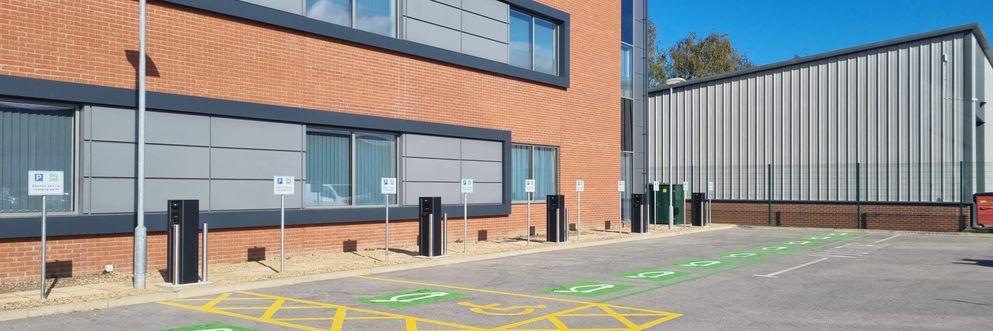
Where are all the electric vehicle charging points?
By Simon Finnie, Executive Director, BAM Ventures
Where are all the electric vehicle charging points?
Our analysis shows that there are three and a half times fewer charging units per EV (Electric Vehicle) than five years ago.
We recently launched BAM’s new Sustainability Strategy, and as part of our commitment to reduce our carbon footprint, we are transitioning to a fully electric fleet of commercial vehicles and company cars.
I was lucky enough to get an Electric Vehicle (EV) early last year and whilst initially sceptical, I’m now a complete convert. Aside from my personal desire to reduce my carbon footprint wherever possible, I’ve seen a significant reduction in my running costs.
Early adopters of EVs experienced ‘range anxiety’ - the worry that there wouldn’t be enough charge in the battery to get them to their destination. Modern cars now have significantly longer ranges and mine is about 280 miles (when it’s not cold outside), which is more than enough to get to most places.
But when I speak to other EV owners, concerns haven’t disappeared rather they’ve shifted to ‘EV charger anxiety’. That is the risk of relying on a working and available EV charging unit in the location you’re travelling to. I recently drove to Huddersfield from London and checked beforehand that there were multiple chargers I could use. When I actually went to use them, they were all out of action or had cars (some non-electric!) parked in the bays. After multiple attempts throughout the day, I finally managed to use an extremely expensive charger out of desperation. Bumping into a number of drivers doing the same circuit of available chargers, I knew I wasn’t alone.
The numbers don’t add up
Looking at the numbers, there simply aren’t enough EV chargers across the UK. If you look at the December figures from SMMT (see figure 1) helpfully collated by Zap Map, then you can see that at the end of December 2022 there were more than 660,000 EVs, an incredible growth of 40% on the previous year.
Number of public UK charging points by speed (2016 to date)

Source: Zap-Map database, SMMT, December 2022
Figure 1 – Cumulative number of EVs in the UK (2016 – 2022)
This is great in terms of the UK moving forward in its transition to a lower carbon transport option (we’re currently 5th in the world per capita) but is only sustainable if the number of Electric Vehicle Chargers (EVCs) keeps up.
And there is definitely progress to address this; as you can see from Graph 2 (again provided by Zap Map) the number of EVCs has increased significantly. Between 2016 and 2022, the UK charge point network grew from 6,500 to more than 37,000 devices, with last year alone seeing growth of 36%.
Number of public UK charging points by speed (2016 to date)

Source: Zap-Map database. Updated 31st December 2022
Figure 2 – Cumulative number of UK charging points in the UK (2016 – 2022)
There aren’t enough working chargers across the UK
Unfortunately, as I mentioned from my personal experience, not all of these charging units are active and operating on a daily basis. An investigation into this by Channel 4’s Dispatches programme found that over 5% of EVCs were broken at any one time - meaning roughly 2,000 EVCs are not working right now.
This just compounds the main issue, namely that the rate of increase in chargers is nowhere near close to the increase in the number of vehicles. At the end of 2016, there were 26,000 plug-in EVs and around 5,000 charging points across the UK – or about one charging unit per five cars. By the end of 2022, we had 660,000 EVs on the road and 37,000 chargers, which brings that figure down to one charging unit per eighteen cars.
In effect, there are three and a half times fewer charging units per EV compared to five years ago. The situation has been alleviated slightly by the restricted supply of EVs generally, but at the current rate the under-supply of charging points is only going to get worse.
It’s time to catch up
We are not the first country to face this challenge and we won’t be the last. I spend a lot of time in the Netherlands and they are about five years ahead of us in this area. The Dutch government recognised that they had to invest heavily in charging infrastructure if they didn’t want to see the EV market implode and disappear.
So, it starts with UK Government and a lot has already been done, including: The Workplace Charging Scheme; the £10 million Local Electric Vehicle Infrastructure (LEVI) pilot; the ORCS (On-Street Residential Chargepoint Scheme); and the overall strategy, ‘Taking charge: the electric vehicle infrastructure strategy’, which sets a target of around 300,000 public charge points in the UK by 2030.
But there are further steps the government could take to accelerate the creation of EV infrastructure:
- Provide financial incentives: The UK government should provide tax credits to businesses and individuals who install EV chargers and importantly make them publicly available.
- Streamline regulations: The UK government should make it easier to install single and multiple EV chargers by streamlining regulations, and improve collaboration between the planning departments, operators and National Grid.
- Provide direct investment: The UK government should set up a fund that invests in EVC infrastructure, generating a return over time that can be re-invested in charging technology.
- Facilitate indirect investment: The UK Government could encourage the private sector to invest in EV charging infrastructure by offering guarantees and tax incentives. This could even be extended into public-private partnerships.
The solution though, does not end with government intervention. History tells us that without an engaged private sector, such infrastructure runs a high risk of failure. With the rise in EV sales, it is clear that with the right framework, investing in the UK’s charging network is an attractive opportunity both financially and in terms of environmental and social impact.
At BAM, we see the growing UK EVC market as one that not only gives us access to new revenue streams, but more importantly, is aligned with our newly published Sustainability Strategy. Our employees and partners tell us that they want to see BAM play an active role in moving the UK to zero-emission motoring.
This is why in 2022, my team set up BAM Charging Solutions. We have already seen significant up-take of this service and have provided both public and private sector clients with high-quality multiple charging station set-ups. We have also started offering ongoing maintenance packages to charging point owners to improve their availability.
It would be easy to focus on the negatives - mainly that we run a real risk that the transition to zero-emission motoring will lose momentum due to the lack of infrastructure. However, it is only because of the successful adoption of electric vehicles that we are now in this situation – and fixing the issue is well within our grasp. While I’ve outlined specific actions above, the bottom line is that success will depend on government and industry coming together. Only then will EV drivers feel comfortable that we can rely on finding a charging point wherever we are in the UK.


